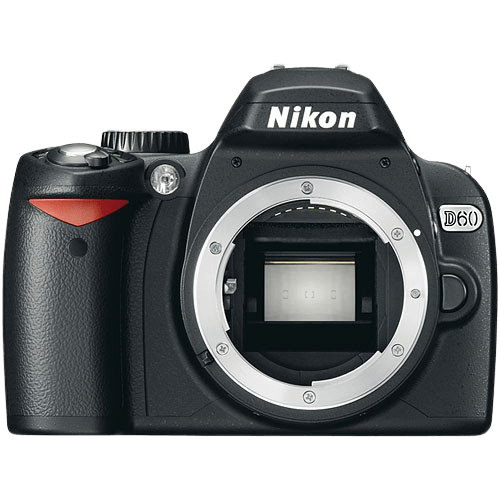Nikon D60 Specs and Scores

The Nikon D60 scores a 34/100 in our evaluation. This DSLR camera, announced on January 29, 2008, and released the same year, had a launch price of $470. Measuring 126 x 94 x 64mm and weighing 522g (1.15lbs), the D60 is a compact and lightweight option for photographers. However, considering the advancements in today’s market, the D60 may not be the most competitive choice for modern photography needs.
Nikon D60 Overview and Optics
The optics of the Nikon D60 receive a score of 43/100. This camera features 10.2 megapixels, a shooting speed of 3 frames per second, and a CCD sensor type. It uses an Expeed processor, has a DXOMARK score of 65 for the sensor, and an APS-C sensor size. The Nikon D60 is compatible with Nikon F DX lens mounts and has an aspect ratio of 3:2. However, it lacks image stabilization.
Comparing these specifications to today’s market, the Nikon D60 falls short in terms of megapixels, shooting speed, and the absence of image stabilization. Many modern cameras boast higher megapixel counts and faster shooting speeds, which contribute to better image quality and versatility. Additionally, image stabilization has become a standard feature in contemporary cameras, providing improved sharpness and reduced camera shake.
Despite its lower score, the Nikon D60 remains a decent option for those seeking a simple and affordable camera with basic features. Its compatibility with the Nikon F DX lens mount allows for a wide range of lens options, and its Expeed processor and APS-C sensor size still deliver acceptable image quality. However, for those seeking advanced features and improved performance, other cameras in the market may be more suitable.
Nikon D60 Video Performance
The Nikon D60 lacks video capabilities. This camera focuses on photography only and does not offer any video recording functions. Users seeking video features should consider other camera models.
Nikon D60 Features and Benefits
The Nikon D60’s features score is 17/100, which reflects its limited functionality when compared to modern cameras. The screen size is 2.5 inches with a resolution of 230,000 dots. The D60 lacks a touchscreen, flip screen, GPS, WIFI, and Bluetooth capabilities.
In today’s market, these specifications are outdated. Most current cameras have larger screens with higher resolution, touch controls, and connectivity options. The absence of a flip screen and touchscreen impacts the user experience, making it less convenient and versatile. The lack of GPS, WIFI, and Bluetooth further limits the camera’s compatibility with modern devices and applications.
The Nikon D60’s features are not competitive in the current market. Its limited specifications make it less appealing to photographers who require advanced functionality and connectivity. The D60’s low feature score reflects the camera’s inability to meet the demands of today’s photography landscape.
Nikon D60 Storage and Battery
The storage and battery section of the Nikon D60 receives a score of 27 out of 100. This camera has only one memory card slot, accepting SD, SDHC, and MMC cards. In the current market, having a single memory card slot may not be sufficient for professional photographers who need backup storage options.
The Nikon D60 uses an EN-EL9 battery, providing 500 shots per charge. This battery life is average for a DSLR camera but falls short when compared to newer models with longer-lasting batteries. Additionally, the camera lacks USB charging, which is a drawback for users who prefer on-the-go charging options.
Taking these specifications into account, the Nikon D60’s storage and battery capabilities may not meet the demands of today’s competitive camera market.
